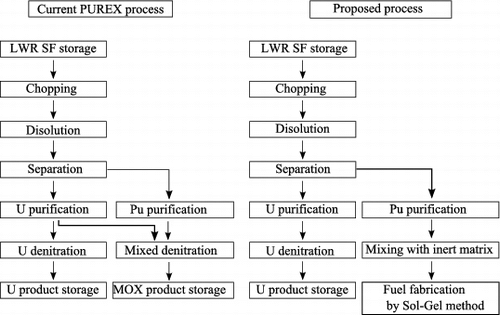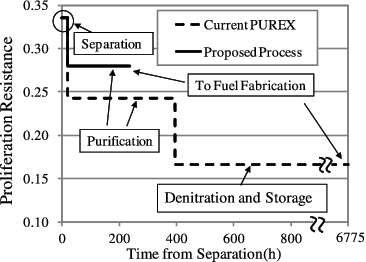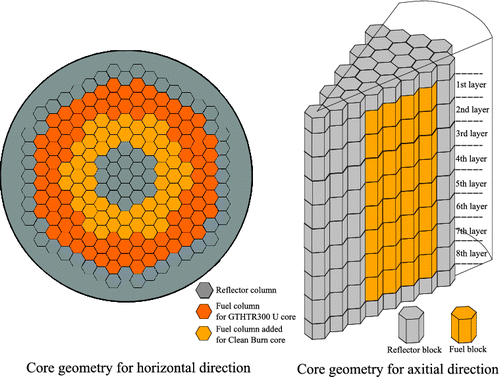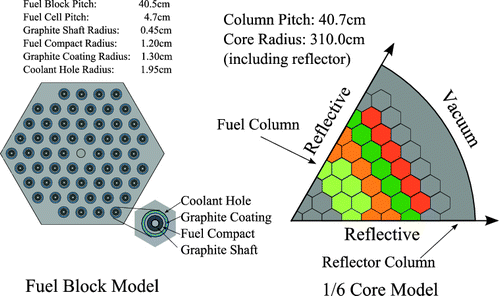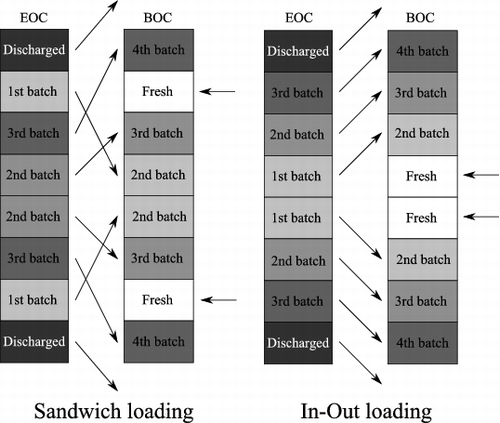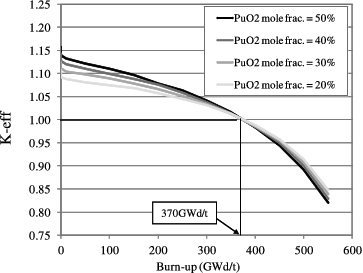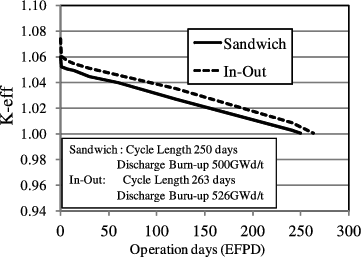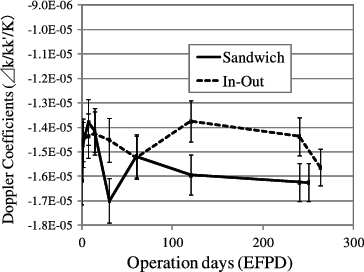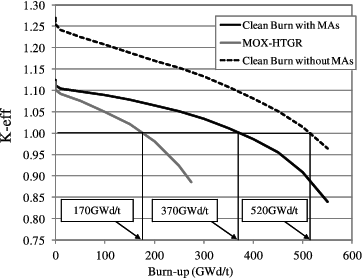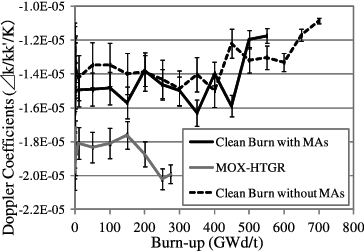Abstract
An innovative plutonium burner concept based on high temperature gas cooled reactor (HTGR) technology, “Clean Burn”, is proposed by Japan Atomic Energy Agency (JAEA). That is expected to be as an effective and safe method to consume surplus plutonium accumulated in Japan. A similar concept proposed by General Atomics (GA), Deep Burn, cannot be introduced to Japan because of its adopting highly enriched plutonium, which shall infringe on a Japanese nuclear nonproliferation policy according to Japan–US reprocessing negotiation. The Clean Burn concept can avoid this problem by employing an inert matrix fuel (IMF) and a tightly coupled fuel reprocessing and fabrication plants. Both features make it impossible to extract plutonium alone out of the fabrication process and its outcomes. As a result, the Clean Burn can use surplus plutonium as a fuel without mixing it with uranium matrix. Thus, surplus plutonium alone will be incinerated effectively, while generation of plutonium from the uranium matrix is avoided. High neutronic performance, i.e., achievement of burn-up of about 500 GWd/t and consumption ratio of plutonium-239 reaching to about 95%, is also assessed. Furthermore, reactivity defect caused by the inert matrix is found to be negligible. It is concluded that the Clean Burn concept is a useful option to incinerate plutonium with high proliferation resistance.
1. Introduction
About 44 tons of recovered plutonium had accumulated in Japan by 2012 [Citation1]. It will further increase by about 8 tons per year after the operation of a reprocessing plant at Rokkasho gets restarted. However, there is not enough capability to consume plutonium by Japan's nuclear reactors yet. There are only four units of light water reactor (LWR) to utilize mixed oxide (MOX) fuel (partially loaded) which is in contrast to the fact that about 13 units of LWRs with 1/3 MOX fuel core should be installed to consume 8 tons of plutonium per year. The plutonium beyond the consumption capacity is considered to be “surplus plutonium” [Citation2], which attracts strong concerns from nuclear non-proliferation point of views. The surplus plutonium should therefore be incinerated properly. Moreover, the Fukushima Daiichi nuclear disaster, which occurred on 11 March 2011, affects the nuclear option in Japan to accelerate the decrease of the surplus plutonium as well as to achieve high safety of nuclear reactors. In this context, several concepts of plutonium burner reactors such as fast reactors (FR) [Citation3], accelerator-driven systems (ADS) [Citation3], LWRs with rock-like oxide (ROX) fuel [Citation4], have been proposed and discussed.
A concept based on high temperature gas-cooled reactor (HTGR) called “Deep Burn” [Citation5] proposed by General Atomics (GA) is one of the options of a plutonium burner because of its high ability to incinerate fissionable nuclides (about 95% of plutonium-239 with significantly high burn-up of about 500 GWd/t) by only once through and taking advantage of inherent safety features of HTGR. In other words, Deep Burn can incinerate plutonium effectively and safely. However, the Deep Burn employs a fuel composed of only TRansUranium (TRU) nuclides from LWR spent fuel, which has a plutonium enrichment of almost 100 wt%. Such fuel is not acceptable to Japan's nuclear fuel cycle environment in terms of nuclear nonproliferation policy. As a matter of fact, the separated and recovered plutonium must be mixed with the same amount of recovered uranium before a denitration process (called mixed denitration) in Japanese Plutonium-URanium EXtraction (PUREX) reprocessing due to Japan–US reprocessing negotiation. In other words, the plutonium enrichment is restricted below 50 wt% in the current reprocessing scheme. This restriction would defect the efficiency of incinerating plutonium. If the restriction is to be removed, however, it must be done so without degrading proliferation resistance.
In the present study, we propose an innovative plutonium burner system, which can incinerate plutonium as much as the Deep Burn, without mixing it with uranium, yet possessing high proliferation resistance. We call this system as “Clean Burn”. We have designed the Clean Burn so that it should have higher proliferation resistance than current LWR fuel cycle to be accepted in Japan's nuclear fuel cycle environment and also have desired neutronic characteristics. In the past, Japan Atomic Energy Agency (JAEA) had built a high temperature engineering test reactor [Citation6] (HTTR), which is a prismatic type HTGR with a 30 MW thermal power. The HTTR has produced useful experimental data by, e.g., safety demonstration tests [Citation7] and a 50-day continuous operation test [Citation8]. Moreover, JAEA has been conducting design study of GTHTR300 series [Citation9]. It is a commercial HTGR with a 600 MW thermal power and has an annular type core, which is the same type as Deep Burn. In this way, JAEA has accumulated experiences of HTTR and GTHTR300 design. These experiences are employed efficiently to design the Clean Burn, which will be described in this paper.
The features of Clean Burn are summarized as follows:
high proliferation resistance by employing inert matrix fuel (IMF) and a tightly coupled plant of fuel reprocessing and fabrication;
high plutonium incineration ability.
The main objective is to incinerate fissile plutonium “Cleanly.” For fissile nuclides, plutonium-241 has the short half-life of 14.4 years. On the contrary, the half-life of plutonium-239 is a long term of 24,100 years. For the risk of proliferation after geological disposition, only plutonium-239 is a problem. Thus, the target of Clean Burn concept is to incinerate around 95% of loaded plutonium-239. We defined this target as “Cleanliness.” Moreover, we are planning to perform research and development to realize inherent safety for Clean Burn by taking advantage of safety features of HTGR.
To establish the Clean Burn concept, the fuel and fuel fabrication system are proposed in Section 2. The neutronic feasibility and the neutronic characteristics are described in Section 3. R&D subjects for Clean Burn are described in Section 4.
2. Fuel of Clean Burn and fuel fabrication with high proliferation resistance
2.1. Current PUREX process and proposed process
As described in Section 1, the plutonium must be mixed with the recovery uranium, and the enrichment must be less than 50 wt% in the present situation in the Japanese nuclear fuel cycle environment due to the Japan–US reprocessing negotiation. Thus, the plutonium consumption efficiency is defected significantly by the plutonium generation from the fuel matrix of uranium. If an alternative reprocessing system to treat pure plutonium without uranium mixing would be proposed, the system should have the higher proliferation resistance than the existing one to be accepted in Japanese nuclear fuel cycle environment.
In this context, an innovative plant system [Citation10] combining LWR spent fuel reprocessing and HTGR fuel fabrication with high proliferation resistance is proposed in the present study to avoid this problem. The process flow of the current PUREX in Japan and proposed process in the present study is shown in . If the fuel composed only of TRU like a Deep Burn fuel would be fabricated with the current PUREX without mixed denitration, the MOX product with high plutonium enrichment over 50 wt% is generated and transported from reprocessing facilities to fuel fabrication facilities. The proliferation resistance becomes significantly depleted. Therefore, we propose the innovative LWR spent fuel reprocessing and fuel fabrication system as follows. The purified plutonium of nitrate solution is mixed with inert matrix of yttria-stabilized zirconia (YSZ) instead of recovered uranium, and the route of the nitrate plutonium solution is connected to the fuel fabrication process of Sol-Gel method [Citation11] directly. Due to the changes, the proliferation resistance is improved. This system can be established only by combining the current process of PUREX and HTGR fuel fabrication without significant changes.
2.2. Estimation of proliferation resistance for current PUREX process and proposed process
To assess the proliferation resistance of the proposed system, we evaluated the proliferation resistance for plutonium material using the method proposed by W. Charlton [Citation12]. The assessment method can measure the proliferation resistance for each process according to several categories such as attractiveness for weapons, heat generation, plutonium composition, concentration, radiation dose, etc. The proliferation resistance is evaluated by summation of utility functions for each category with weight as follows:
(1)
where PRi is the proliferation resistance of process i, wj is the weight for attribute j, uj is the utility function for attribute j, and xij is the input values for the utility function for attribute j in process i.
The weight for the attributes was determined by soliciting input from the specialists in the fields of nuclear security, nonproliferation, international security, nuclear safeguards, nuclear smuggling, and law enforcement [Citation2].
For example, the utility functions of “concentration,” “inventory,” and “physical barriers,” which generally change for each reprocessing process, are defined as described below.
The utility function for the concentration u4 is defined as follows:
(2)
where x4 is the concentration for the material in the unit of SQs/ton and x4, max is the concentration for pure plutonium metal (125 SQs/ton).
SQ stands for “significant quantity.” The definition [Citation13] by International Atomic Energy Agency (IAEA) is the approximate amount of nuclear material for which the possibility of manufacturing a nuclear explosive device cannot be excluded. The SQ for plutonium is 8 kg [Citation13]. The concentration metric considers the concentration of fissile material in the process step. Higher concentration materials will be more attractive since a lower mass (or volume) of material would need to be diverted or stolen to acquire a useable mass of special nuclear materials (SNMs) or alternate nuclear materials (ANMs).
The utility function for the inventory u13 is defined as follows:
(3) where x13 is the total facility inventory in the unit of SQs and x13, max is the maximum possible inventory (100 SQs).
The utility function for physical barriers is a constructed scale listed in . The scale was chosen to reflect a decrease in proliferation resistance as the difficulty in accessing the material decreases. “Inaccessible” implies that the material cannot be physically accessed (for instance, material being irradiated in a PWR). A “Canyon” refers to a completely enclosed, underground structure to which it is very difficult to gain access. A “Vault” refers to a large structure that impedes access to the material (a spent fuel pool was considered a vault in this work). “Secure” refers to sealed containers in which material may be stored (this could include drums or barrels). “Remote” would refer to any system in which its location alone makes it inaccessible to the proliferator (a geological repository is typically one example of this). “Hands-on” refers to engineered configurations in which the material can be at least indirectly handled (i.e., very limited physical barriers, such as a glove box).
Table 1. Utility function for physical barriers.
In addition, in the evaluation of the proliferation resistance of a new nuclear system, the target should be the proliferation resistance of the current LWR technology, which is the de facto standard of nuclear power industry.
To assess the acceptability of the proposed process from the viewpoint of proliferation resistance, the proliferation resistance was evaluated and compared with that of current PUREX process. In this evaluation, the Rokkasho reprocessing plant is assumed as the representative reprocessing plant. The proliferation resistance was evaluated for the process after the separation process of plutonium product stream, because the process before the separation process is common for the two processes. The result is shown in , and the utility functions are listed in and , for the current PUREX process and the proposed process, respectively. The proliferation resistance of the plutonium purification process for Clean Burn is improved from the current PUREX process from 0.243 to 0.280. Moreover, the denitration and storage process, where the significant depletion of proliferation resistance is observed in the current PUREX process, is omitted in the proposed process as described in Section 2.1.
Table 2. Proliferation resistance with utility function for current PUREX process.
Table 3. Proliferation resistance with utility function for proposed process.
In the plutonium purification process, the nitrate solution is concentrated by water evaporation. The target concentrations are different among the two processes. The target concentration for the current PUREX process is set to be 250 gram-Pu/lit. required by the next process of the mixed denitration. On the other hands, the target concentration for the proposed process should be less than 240 gram-Pu/lit., which is required by the next process of the fuel fabrication using Sol-Gel method [Citation11]. The Sol-Gel method needs 2 mol-metal/lit. of the nitrate solution with plutonium, zirconium, and yttrium. The mole fraction of plutonium should be less than 50% corresponding to the half and half composition of plutonium and uranium for the mixed denitration according to the Japan–US reprocessing negotiation. The mole fraction of 30% is preferable as mentioned in Section 3 and corresponding to 144 gram-Pu/lit. This concentration was used in this evaluation. The proliferation resistance of the proposed process is improved because of the lower plutonium concentration for fuel fabrication than that of the denitration for the current PUREX. The utility function for concentration is improved from 0.607 to 0.730. The utility function for inventory is improved from 0.399 to 0.893 because the reduction of the concentration also reduces the inventory filling the specific volume of the process. In the purification process, it was assessed that the proliferation resistance of the proposed process is no less than that of current PUREX process.
On the other hand, the proliferation resistance of denitration and storage process will be significantly improved by introduction of the proposed process because the denitration and storage process itself is omitted and the route of the nitrate plutonium solution is connected to the fuel fabrication process directly. The physical barrier of the route is regarded as “Secure” and the utility function is 0.5 in the present study. We defined the proliferation resistance of the proposed process in the denitration and storage process as unity as listed in because the risk of proliferation does not exist. For the current PUREX process, the utility function for the physical barrier is zero because the production of MOX powder is packed in cans, which are portable, and the physical barrier is regarded as “Hands-on” in . Generally, the storage duration, where the plutonium products take portable form, is long and degrades the proliferation resistance. It is concluded that the proposed system has a high proliferation resistance.
In addition, the produced Clean Burn fuel, which is composed of fuel compact matrix and TRi-ISOtropic (TRISO) fuel with the IMF kernel, has higher proliferation resistance than LWR-MOX fuel. Here, we refer to the concept of conversion time defined by IAEA. The definition of the conversion time [Citation13] is the time required to convert different forms of nuclear material to the metallic components of a nuclear explosive device. It is one factor used to establish the timeliness component of the IAEA inspection goal via another concept of detection time. The material, which has a long conversion time, has high proliferation resistance. To reprocess the TRISO fuel, the complex head-end process, which surely increases the conversion time in comparison with the LWR reprocessing performing just chopping, is needed to connect the PUREX process. The head-end process developed in JAEA [Citation14] is described as follows. First, the fuel compact matrix and outer PyC layer composed of graphite are removed by burning. Second, to remove the SiC layer of the TRISO fuel particles, the layer is crashed mechanically by jet grind method or hard disk crusher. Third, to remove FP gas to reduce the radioactivity release for later processes, the fuel particles are burned again to adapt voloxidation method. This process is essential to remove inner PyC layer and buffer layer of fuel particles. There are great difficulties in the engineering of these processes especially for the crashing of the SiC layer. The SiC layer should be crashed effectively without crash of fuel kernel, which causes radioactive pollution. The exposure contributes the proliferation resistance, which is suggested by the difference of the conversion times between un-irradiated fuel (order of weeks (1–3) [Citation13]) and irradiated fuel (order of months (1–3) [Citation13]).
Moreover, the IMF kernel of YSZ cannot be solved in ordinary nitrate solution owing to chemically inert characteristics [Citation15]. To solve the YSZ kernel, it is inevitable to add the hydrogen fluoride [Citation16]. The hydrogen fluoride is difficult to treat because that also corrodes the dissolver due to the very strong acids. As a result, it is found that the Clean Burn fuel has more “proliferation technical difficulty,” “proliferation cost,” and “proliferation time,” which are categorized as the essence of proliferation resistance in the Generation IV International Forum (GIF) [Citation17], than LWR–MOX fuel. This conclusion does not change even if innovative technology would be employed to treat Clean Burn spent fuel easily. This is because the innovative technology itself is regarded as “proliferation technical difficulty” and/or “proliferation cost,” which are the elements of proliferation resistance.
As described above, with employing the proposed reprocessing and fuel fabrication system and IMF, the Clean Burn can incinerate plutonium without mixing with other actinoid nuclides with high proliferation resistance.
3. Neutronic feasibility and neutronic characteristics
3.1. Calculation method and model
As described in Section 1, to take advantage of the HTGR development experience in JAEA, Clean Burn has been developed based on GTHTR300. However, the number of fuel columns is increased from 90 to 144, which is the same as Deep Burn as a result of reduction of the plutonium inventory per one fuel column to moderate neutron effectively. The plutonium nuclides have large neutron absorption cross section compared with the uranium nuclides. If a large amount of plutonium is loaded in a few fuel columns, neutrons are absorbed before moderation to thermal energy region. Therefore, the number of fuel columns should be increased.
The core geometry is shown in . The fuel columns are composed of eight fuel blocks, which have a height of 1 m, for axial direction. The core height is 8 m. As described above, HTGR fuels are divided for axial direction. In the present study, the neutronic feasibility is assessed by core burn-up calculation using the Monte Carlo neutron transport code MVP [Citation18] with evaluated nuclear data of JENDL-4.0 [Citation19]. Moreover, a statistical geometry model [Citation20] is also employed to treat double heterogeneity for coated fuel particle (CFP) directly. Two core models are employed for preliminary analysis to optimize the core design using parameter survey and final analysis to assess the neutronic feasibility.
The first model is the two-dimensional model for one-sixth core. The calculation model is shown in . In this model, only one fuel layer is modeled and the reflective boundary condition is set for the top and bottom of one layer. The neutron leakage effect for axial direction cannot be treated in this model. However, the core height of 8 m is high enough to ignore neutron leakage effect from the top and bottom of the core, which is the reactivity worth about 0.5% Δk/kk′ and negligible to determine achievable burn-up. The burn-up calculations are performed without fuel reloading as one-batch core, and the achievable burn-ups of one-batch core are estimated. Instead of considering the fuel reloading directly, the achievable burn-up is predicted using the following relation [Citation21]:
(4)
where Bn-batch is the discharge burn-up of n-batch core, Bone-batch is the discharge burn-up of one-batch core, and n is the number of batches.
This relation is conducted with the assumption that the criticality linearly changes with the burn-up. In the present study, the burn-up is multiplied by 1.6 to consider the achievable burn-up for four-batch core with the relation of Equation (4).
The second model is the three-dimensional model with fuel reloading for four-batch one-sixth core. The calculation model for horizontal direction is also shown in . The axial geometry is modeled according to the geometry shown in . The eight fuel layers are divided into four batches and shuffled when the fuels are reloaded. Two loading patterns are considered for fuel loading, i.e., “sandwich loading” and “in–out loading,” in the present study. The sandwich loading was invented for two-batch core in the previous GTHTR300 design study [Citation9]. The old fuels are sandwiched between new fuels. In the present study, the sandwich loading is extended for four-batch core. In–out loading is also employed considering neutronic economy. New fuels are placed at an inner region and old fuels are placed at an outer region. The loading patterns are shown in .
In these models, the control rod and burnable poison (BP) are not considered because the objective is to evaluate burn-up characteristics, which mainly depend on achievable burn-up. The control rod, which is also not considered in the feasibility study on Deep Burn [Citation22], does not give significant difference to achievable burn-up if the control rod is perfectly withdrawn at EOC. In the same manner, it is known that the BP also does not affect the achievable burn-up if the fresh fuel of BP is burned within one cycle. The flux shape distortion is supposed not to affect significantly burn-up characteristics.
In addition, the plutonium composition shown in , which is used in the feasibility study on Deep Burn [Citation22], is used in the present study. The composition includes minor actinoids (MAs) because of assuming URanium EXtraction (UREX) reprocessing, though the MAs cannot be obtained in Japan with the current PUREX reprocessing. The case of fuel composition by PUREX reprocessing is also assessed in Section 3.4.
Table 4. Fuel composition for fresh fuel.
3.2. Determination of Clean Burn fuel configuration
As mentioned in Section 3.1, the number of fuel columns is increased from 90 to 144 as same as Deep Burn. Moreover, plutonium inventory per fuel particle and packing fraction of CFP should be determined. Of course, the plutonium inventory should be preserved for the core considering neutron moderation. The plutonium inventory is determined to maintain the plutonium consumption ability with reasonable cycle length in the feasibility study on Deep Burn [Citation22]. But, the IMF composition of PuO2–YSZ, which is employed as Clean Burn fuel, should be determined. The mole fraction of PuO2 and YSZ can be determined freely according to design requests, because both of them have the same crystal structure of fluorite. Thus, in the present study, the mole fraction of PuO2 is varied from 20% to 50% as listed in . The packing fraction is also varied along with the plutonium dilution with the inert matrix under the condition to preserve the fuel inventory. The fuel specification and calculation conditions, which refer to values for Deep Burn [Citation22] are listed in . The discharged burn-up of 500 GWd/t is set as target in the present study by referring the Deep Burn design value of 546 GWd/t.
Table 5. Fuel compositions and packing fractions of Clean Burn.
Table 6. Fuel specification and calculation condition of Clean Burn.
The parameter survey was performed using the two-dimensional model described in Section 3.1. The result for criticality is shown in . The achievable burn-ups of the one-batch core are almost the same value, which is 370 GWd/t. The burn-ups correspond to 590 GWd/t for the four-batch core. The target burn-up of about 500 GWd/t is achievable. The excess reactivity becomes small along with the plutonium dilution by YSZ. However, it is supposed that the reactivity change is not caused by the existence of YSZ nuclides but by the plutonium dilution. The plutonium dilution increases the number of fuel particles (packing fraction) as mentioned above. There are special neutronic characteristics for HTGR fuel called “double heterogeneity effect.” HTGR fuel has two heterogeneities not only for fuel pins but also for fuel particles in the fuel pins. Shielding effects occur for the both heterogeneities. The dilution weakens the double heterogeneity effect due to the averaging of the fuel particles into the fuel pins and increases the resonance neutron capture reaction rate by fertile nuclides. The criticality is improved by the conversion at the end of burn-up. Therefore, the burn-up reactivity defect is reduced. The dilution effect is preferable to the plutonium burner reactor design based on HTGR such as Deep Burn and Clean Burn from the view point of excess reactivity management. Of course, the effect can also be adopted for ordinary MOX fuel employing small-sized fuel kernel. However, the fuel kernel size cannot be chosen freely, because it is difficult to fabricate the CFP with small-sized fuel kernel. In other words, the Clean Burn fuel is also preferable from the view point of the nuclear design by avoiding the difficulty of the fabrication using the dilution of fuel material. In addition, the effect of neutron capture by the zirconium of IMF is negligible as assessed with the result shown in . In addition, the Doppler coefficients are evaluated as shown in . The Doppler coefficients are defined as the reactivity gradient to fuel temperature from the operation temperature to that increasing with 100 K in the present study. Those coefficients are negative during the operation for all the cases. At the beginning of burn-up, the coefficients show larger values for smaller mole fraction of PuO2. On the contrary, those show smaller values for larger mole fraction of PuO2 at the end of burn-up. The mechanism is same as mentioned for the criticality. The increase of the resonance neutron capture due to the weakening of double heterogeneity enhances the Doppler reactivity effect, which is caused by weakening of a self-shielding effect due to the Doppler broadening of resonance capture peak. At the end of burn-up, the trend of the Doppler coefficients is reversed by the change of the TRU vector due to the conversion.
As described above, the low plutonium mole fraction can reduce the excess reactivity due to the weakening of double heterogeneity effect instead of BP without reduction of achievable burn-up. However, it increases the packing fraction. Finally, the plutonium mole fraction is determined 30% considering the achievable packing fraction of 30% from the view point of fabrication.
3.3 Validation of Clean Burn core design
The neutronic feasibility was validated for the design with the plutonium mole fraction of 30% using the three-dimensional model described in Section 3.1. The criticality during operation is shown in . The cycle lengths for the sandwich loading and in–out loading are 250 and 263 days, respectively, and those correspond to the burn-ups of 500 and 526 GWd/t. The Doppler coefficients were evaluated as shown in . The negative coefficients are assessed during the operation for both of the loading patterns. The coefficient of in–out loading pattern shows slightly large value because the inner region of fuels, which preferentially determines the whole core characteristics, has a small fraction of fertile nuclides because of the low burn-up and shows larger value also in the one-batch calculation shown in . For plutonium consumption, the discharged fuel composition and consumption ratio are shown in . The plutonium-239 consumption ratios are about 95%, fissile nuclide consumption ratios are about 80%, and neptunium and the precursor consumption ratios are about 40%, for both loading patterns. The plutonium-239 consumption ratios satisfy the “Cleanliness” of 95% defined in the present study. The neptunium and the precursor, i.e., nuclide in 4N + 1 series decay chain, significantly contribute to the toxicity release from repository due to the high solubility of neptunium-237 and thorium-229, which is the daughter of neptunium-237, to the groundwater.
Table 7. Fuel composition and consumption ratio of Clean Burn with PuO2 mole fraction of 30% (wt%IHM).
The discharge burn-up of Clean Burn is significantly high of about 500 GWd/t, and that of the plutonium consumption ratio is about 95% as same as Deep Burn. As a result, it was assessed numerically that the core performance as same as Deep Burn can be achieved in spite of employing IMF.
In addition, the model without the control rod and BP is supposed to be valid from the discharged fuel compositions of the two loading patterns. The compositions are similar, and the difference of burn-up characteristics by flux distortion, which is caused by introduction of the control rod and BP, is supposed to be smaller than that of the two loading patterns. Thus, it is assessed that this approach is proper to determine the burn-up characteristics of Clean Burn concept.
3.4. Comparison of neutronic characteristics
In order to assess neutronic characteristics, the representative design of Clean Burn was compared with other two types of designs. The two-dimensional model was used for the analysis. The first case is MOX fueled HTGR (called “MOX-HTGR” in this study). As described in Section 1, the plutonium enrichment is limited to 50 wt% in Japan. The heavy metal inventory is two times larger than that of Clean Burn, because the plutonium inventory is preserved and the same amount of uranium is added. The burn-up becomes a half with the same energy generation due to the increase of the heavy metal. The second case is Clean Burn without MAs. In the present study, to compare the neutronic characteristics of Clean Burn with that of Deep Burn, the plutonium composition used in the feasibility study of Deep Burn is also employed for the estimation of Clean Burn. However, the current PUREX process cannot recover MAs, and alternative process should be developed to incinerate MA nuclides. Therefore, the Clean Burn without MAs, which includes americium-241 generated via β− decay of plutonium-241 in two years cooling, is presented. The fuel composition is set to be the same as Clean Burn except the removal of MAs. On the other hand, Clean Burn presented in the previous section is called “Clean Burn with MAs” in this section.
The result for criticality is shown in . The achievable burn-ups of one-batch core are 170 GWd/t, 370 GWd/t, and 520 GWd/t, respectively, for MOX-HTGR, Clean Burn with MAs, and Clean Burn without MAs. Those values correspond to 270 GWd/t, 590 GWd/t, 830 GWd/t for four-batch core. However, the achievable burn-up obtained by the two dimensional model with one-batch core is overestimated compared with the three-dimensional model with fuel reloading for the four-batch core, because the relation described in Equation (4) was conducted with the assumption that the criticality linearly changes with the burn-up unlike the curved characteristics of the actual Clean Burn design. To correct this mismatch, the achievable burn-ups are multiplied by 0.85 considering the calculation results in Sections 3.2 and 3.3 to a obtain conservative estimation. The modification factor of 0.85 is expected to give appropriate estimation for feasibility studies because the shapes of the multiplication curve shown in are similar. Finally, the burn-ups are 230 GWd/t, 500 GWd/t, and 700 GWd/t. The burn-up characteristics were presented using these burn-ups for MOX-HTGR and Clean Burn without MAs. The Doppler coefficients were evaluated as shown in . For the all cases, negative coefficients are shown during the operation. Clean Burn without MAs shows slightly larger value than Clean Burn with MAs because of the removal of MAs, which are mainly composed of resonance neutron capture nuclides. The coefficient of MOX-HTGR shows the smallest values due to neutron capture reactions of the uranium-238. However, the difference is not significant. It is concluded from these results that the resonance neutron capture reaction of fertile nuclides of reactor grade plutonium is enough to maintain the Doppler coefficient negative during the operation without other resonance neutron capture nuclides. The burn-up characteristics of Clean Burn with MAs were already presented in the previous section. For MOX-HTGR and Clean Burn without MAs, the fuel compositions are shown in and , respectively. For the Clean Burn with MAs, as shown in , the plutonium-239 consumption ratios are about 95%, and fissile nuclide consumption ratios are about 80%. On the contrary, the plutonium-239 consumption ratio of MOX-HTGR is 81.5%, and the fissile nuclides consumption ratio is 63.1%. The consumption ratios are depleted due to plutonium generation from uranium matrix. On the other hand, the plutonium-239 consumption ratio of Clean Burn without MAs is 99.5%, and the fissile nuclides consumption ratio is 93.6%. The consumption ratios become significantly high by the removal of MAs. It was found that the MAs significantly deplete the criticality of Clean Burn and the plutonium incineration ability can be improved with pure plutonium fuel.
Table 8. Fuel composition and consumption ratio of MOX-HTGR(wt%ITRU).
Table 9. Fuel composition and consumption ratio of Clean Burn without MAs (wt%IHM).
4. R&D subjects for Clean Burn
To establish the Clean Burn concept from the view point of engineering, we have the following subjects that need research and development:
detailed nuclear design considering the fuel temperature for safety analysis,
safety analysis for transient event,
fuel design and fabrication of Clean Burn fuel,
dose estimation for Clean Burn spent fuel in geological repository,
introduction scenario for the Clean Burn reactor.
The detailed nuclear design is important to assess engineering feasibility. Installation of control rod and control rod program will be determined under the condition of a maximum fuel temperature limitation.
The safety analysis for transient events should be performed. In the present study, negative Doppler coefficients were assessed. Negative power coefficients are also expected. However, the positive moderator coefficients are concerned because of the giant cross-section peak of plutonium-239 at 0.3 eV near the thermal flux peak of Maxwellian distribution. The negative power coefficients should be assessed in all burn-up and temperature ranges. Moreover, it has not been found yet whether the negative Doppler coefficients are large enough to prevent fuel failure during the transient event. If lack of the Doppler coefficient would be found, we add erbium to the fuel to enhance the negative Doppler reactivity.
For the fuel design, there are some severe conditions for integrity of Clean Burn fuel, i.e., high fluence irradiation, much FP gas release, high yield of platinum group nuclides and silver from plutonium. The spent fuel integrity of TRISO fuel with plutonium oxide kernel with high burn-up of 747 GWd/t (Peach Bottom Unit 1) was confirmed by GA [Citation5]. Moreover, the fuel design and fuel particle (SiC Layer) failure fraction for Deep Burn is evaluated by GA with high burn-up of 700 GWd/t and operation conditions, including high fluence irradiation [Citation23], and the integrity was successfully assessed. Especially, new design adding ZrC layer to TRISO fuel shows an excellent result with perfect prevention of CO gas generation due to the function of oxygen-getter [Citation23]. According to the investigations, the engineering feasibility for Clean Burn fuel is not a problem. We are planning to design the coated fuel particle with ZrC layer and YSZ diluted kernel. Low fuel failure fraction is expected with the superior chemical stability of YSZ. The silver, which has approximately 40 times higher fission yield from plutonium than uranium, penetrates the coating layers and is released into coolant. This is a problem from the viewpoint of exposure. For the silver, the ZrC layer also works as its barrier. R.E. Bullick observed perfect confinement of silver (Ag-110m) [Citation24] by the ZrC layer by post-irradiation examination. The coating technology of Pu-YSZ fuel kernel, including ZrC layer has not been established yet. The engineering feasibility of this process will be validated by mockup examination.
Dose estimation for Clean Burn spent fuel in geological repository is important not only for safety but also for public acceptance. The spent fuel of Clean Burn is basically planned to be disposed of directly. Generally, the radiotoxicity itself confined in geological repository isn't regarded as an environmental burden. But the released toxicity from the geological repository into the biosphere is limited for the safety [Citation25]. As described and evaluated above, 4N + 1 decay series nuclides, i.e., neptunium and the precursors, mainly contribute the toxicity of public exposure and can be reduced approximately to half of the inventory by the transmutation via burn-up of Clean Burn. However, the contribution of the reduction should be quantitatively evaluated because the released amount of the toxicity strongly depends not only on the inventory, but also on durability of waste form, solubility, and mobility in the groundwater. Especially, the durability of waste form is significantly different from the vitrified waste. For the vitrified waste analysis, the release of the radioactive nuclides starts after the lifetime of overpack of one thousand years. On the contrary, the TRISO fuel shows integrity for a long time over one million years. Even after one million years, the failure fraction of fuel particles is predicted [Citation5] to be approximately 0.01%. Moreover, the chemical stability of YSZ is also expected to contribute to the safety in the geological repository. According to a leaching examination [Citation26] performed in JAEA, the leaching amount of cesium, the most movable element in the repository environment, from the IMF is approximately 1/100 of that from vitrified waste. The spent fuel of Clean Burn is expected to contribute to reduction of environmental burden.
Introduction scenario for the Clean Burn reactor should be investigated. The benefit of the introduction will be found out by estimating mass balance under the realistic scenario.
5. Conclusion
An innovative plutonium burner reactor based on HTGR named Clean Burn is newly proposed by JAEA. There is a similar concept called Deep Burn. The objective of Deep Burn is to consume surplus plutonium extracted from reprocessing the LWR spent fuel effectively and safely. However, the proliferation resistance is not enough to introduce this concept in Japan, because Deep Burn employs the fuel composed of only TRU without mixing uranium. The Clean Burn concept is an alternative one with high proliferation resistance by employing IMF and innovative unit plant system of fuel reprocessing and fabrication proposed in the present study. The proliferation resistance is assessed quantitatively by using the assessment method proposed by W. Charlton. With the Clean Burn, the plutonium without mixing uranium can be burned even in Japan or in other countries requiring plutonium burner reactors with high proliferation resistance.
The neutronic feasibility was assessed by core burn-up calculations. As a result, it was found that the IMF of Clean Burn does not cause reactivity defect unlike uranium matrix fuel such as MOX-HTGR from the neutronically inert characteristics; moreover, the IMF is preferred to optimize neutronic characteristics by weakening double heterogeneity effect. The target burn-up of about 500 GWd/t can be achieved. The high plutonium-239 consumption ratio of about 95% was also assessed. This satisfies the “Cleanliness” of 95% defined in the present study. The Clean Burn core design can be established with the same performance of Deep Burn in spite of employing IMF.
Moreover, the characteristics of Clean Burn (Clean Burn with MAs) were specified by comparing with other types of reactors, i.e., MOX-HTGR, Clean Burn without MAs. The plutonium consumption ratio of MOX-HTGR is significantly depleted by plutonium generation from uranium matrix. In other words, the high plutonium incineration ability of Clean Burn can be achieved by employing IMF to avoid plutonium generation from fuel matrix. More effective plutonium incineration can be performed if Clean Burn employs the pure plutonium without MAs owing to the preferable neutron economics according to the calculation result of Clean Burn without MAs. For all cases, negative Doppler coefficients are assessed without other additive nuclides. The amount of fertile nuclides of reactor grade plutonium is large enough to maintain the Doppler coefficient negative.
Finally, the R&D subjects for Clean Burn are selected. We are planning to conduct R&Ds to ensure the concept from the view point of engineering.
It is concluded that the Clean Burn can be a useful option for the plutonium incineration in Japan and in other countries requiring plutonium burner reactors with high proliferation resistance.
Acknowledgements
The authors wish to thank Dr M. Ogawa, Dr R. Hino, Dr X. Yan, Dr S. Nakagawa, Dr J. Sumita, Dr S. Ueta, Dr J. Aihara, Dr H. Sato, Dr H. Akie of JAEA, and Prof. T. Iwamura of University of Fukui for their cooperation in the Clean Burn concept.
References
- Cabinet Office of Japan. The current situation of plutonium management in Japan. Tokyo: Cabinet Office of Japan; 2012. Available from: http://www.aec.go.jp/jicst/NC/iinkai/teirei/siryo2012/siryo39/120911e.pdf.
- IAEA. Communication received from certain member states concerning their policies regarding the management of plutonium. Vienna: IAEA; 1998. INFCIRC/549/Add.1. Available from: http://www.iaea.org/Publications/Documents/Infcircs/1998/infcirc549a1.pdf.
- NEA. Accelerator-driven System (ADS) and Fast Reactors (FR) in advanced nuclear fuel cycle. Paris: OECD/NEA; 2002. NEA3109. Available from: https://www.oecd-nea.org/ndd/reports/2002/nea3109.html.
- Akie H, Takano H, Anoda Y. Core design study on rock-like oxide fuel light water reactor and improvements of core characteristics. J Nucl Mater. 1999;47:139–145. PII:S0022-3115(99)00081-1.
- Rodiriguez C, Baxter A, McEachern D, Fikani M, Venneri F. Deep-Burn: making nuclear waste transmutation practical. Nucl Eng Des. 2003;222:299–317. doi:10.1016/S0029-5493(03)00034-7.
- Saito S, Tanaka T, Sudo Y, Baba O, Shindo M, Shiozawa S, Mogi h, Okubo M, Ito N, Shindo R, Kobayashi N, Kurihara R, Hayashi K, Hada K, Kurata Y, Yamashita K, Kawasaki K, Iyoku T, Kunitomi K, Maruyama S, Ishihara M, Sawa K, Fujimoto N, Murata I, Nakagawa S, Tachibana Y, Nishihara T, Oshita S, Shinozaki M, Takeda T, Sakaba S, Saikusa A, Tazawa Y, Fukaya Y, Nagahori H, Kikuchi T, Kawaji S, Isozaki M, Matsuzaki S, Sakama I, Hara K, Ueda N, Kokusen S. Design of high temperature engineering test reactor (HTTR). Japan Atomic Energy Research Institute; 1994. JAERI 1332.
- Nakagawa S, Takamastu K, Tachibana Y, Sakaba N, Iyoku T. Safety demonstration tests using high temperature engineering test reactor. Nucl Eng Des. 2004;233:301–308. doi:10.1016/j.nucengdes.2004.08.016.
- Goto M, et al. Long-term high-temperature operation of the HTTR. Nucl Eng Des. 2012;251:181–190. doi:10.1016/j.nucengdes.2011.10.047.
- Yan X, Kunitomi K, Nakata T, Shiozawa S. GTHTR300 design and development. Nucl Eng Des. 2003;222:247–262. doi:10.1016/S0029-5493(03)00030-X.
- Fukaya Y, Takamatsu K, Goto M. Reprocessing process and reprocessing plant for nuclear spent fuel. Patent Application 2012-240391: 2012-10-31. Japanese.
- Shiratori T, Yamashita T, Ohmichi T, Yasuda A, Watarumi K. Preparation of rock-like oxide fuels for the irradiation test in the Japan Research Reactor No. 3. J Nucl Mater. 1999;274:40–46. PII:S0022-3115(99)0061-6.
- Charlton W, Lebouf R, Gariazzo C, Ford D, Beard C, Landsberger S, Whitaker M. Proliferation resistance assessment methodology for nuclear fuel cycle. Nucl Technol. 2007 Feb;157:143–156.
- IAEA. Safeguards glossary. 2001 ed. Vienna: IAEA; 2001. ISBN: 92-0-138602-8.
- Sumita J, Ueta S, Kunitomi K, Yoshimuta S, Sawa K. Reprocessing technologies of the high temperature gas-cooled reactor (HTGR) Fuel. Nihon-Genshiryoku-Gakkai Shi (J At Energy Soc Jpn). 2003;2:546–554. Japanese.
- Akie H, Muromura T, Takano H, Matsuura S. A new fuel material for once-through weapons plutonium burning. Nucl Technol. 1994;107:182–192.
- Shirasu N, Yamashita T, Kanazawa H, Kimura Y, Sudo K, Magara M, Inagawa J, Kono N, Nakahara Y. Burn-up measurement of irradiated rock-like fuels. Tokai-mura: Japan Atomic Energy Research Institute; 2001. JAERI-Research 2001-018. Japanese.
- The proliferation resistance and physical protection evaluation methodology expert group of the Generation IV International Forum. Evaluation methodology for proliferation resistance and physical protection of Generation IV Nuclear Energy Systems: Revision 5 OECD/NEA. 2006 Nov. GIF/PRPPWG/2006/005. Available from: http://www.gen-4.org/Technology/ horizontal/PRPPEM.pdf.
- Nagaya Y, Okumura K, Mori T. A Monte Carlo neutron/photon transport code MVP 2. Trans Am Nucl Soc. 2006;95:662–663.
- Shibata K, Iwamoto O, Nakagawa T, et al. JENDL-4.0: a new library for nuclear science and engineering. J Nucl Sci Technol. 2011;48:1–30. doi:10.1080/18811248.2011.9711675.
- Murata I, Takahashi A, Mori T, et al. New sampling method on continuous energy Monte Carlo calculation for pebble bed reactors. J Nucl Sci Technol. 1997;24:734–744.
- Graves HW Jr. Nuclear fuel management. New York (NY): John Wiley & Sons; 1979. ISBN: 978-0471031369.
- Kim T, Taiwo T, Hill R, Yang W, Venneri F. A feasiblity study of reactor-based deep-burn concepts. Argonne: Argonne National Laboratory; 2005. ANL-AFCI-155.
- Richards MB. Deployment of FBR/VHTR systems for Japan's future energy demands. San Diego, CA: General Atomics; 2007. GA-A25934.
- Bullock RE, Kaae JL. Performance of coated UO2 particles gettered with ZRC. J Nucl Mater. 1983;115:69–83.
- Japan Nuclear Cycle Development Institute. Second progress report on research and development for the geological disposal of HLW in Japan – H12: project to establish the scientific and technical basis for HLW disposal in Japan – Project Overview Report. Tokai-mura: Japan Nuclear Cycle Development Institute. 2000. JNC TN1410 2000-001.
- Kuramoto K, Nitani N, Yamashita T. Durability test on irradiated rock-like oxide fuel. J Nucl Mater. 2003;319:180–187. doi:10.1016/S0022-3115(03)00149-1.

